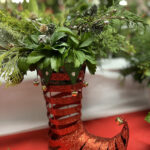Grow bags and outdoor containers
Simply pour or scoop fresh potting soil into your container and level off the top. Fill to about ¾ to the top of the container. Do not use soil from your yard or commercially sold topsoil and garden soil.
Tip: fresh potting soil is recommended for beginners, but you can reuse potting soil from last season if you dry it, clean it of all debris, add compost and a slow-release fertilizer or worm castings.
Preparing soil for outdoor gardens
- If starting with raised beds or previous garden beds, remove all weeds, rocks, and sticks from your garden area. Break up large clumps of dirt. Loosen the soil with a garden fork or rake, add soil amendments if required, and rake the area into an even, level surface. Avoid stepping on the soil in your raised garden bed.
- More in-depth tips for preparing your raised beds can be found online at https://learn.eartheasy.com/articles/raised-beds-preparing-your-garden-beds-for-spring/
- If you are starting a brand-new garden bed, we recommend using a no-till method of planting. This means you do not have to dig up a whole new garden area. Try an unframed raised bed for a small area this first year. For next season you can prepare a larger area using the no-till “lasagna” gardening method.
- Lasagna gardening is a no-dig, no-till organic gardening method that results in rich, fluffy soil with very little work from the gardener. The name “lasagna gardening” refers to the method of building the garden: adding layers of organic materials that will “cook down” over time, resulting in nutrient-rich soil that will help your plants thrive. This is also known as sheet composting. One of many online articles discussing this method of preparing a garden bed is https://www.homesandgardens.com/gardens/lasagna-gardening.
- Most plants grow best in loamy soil —a balanced mixture of sand, clay, and silt. If your soil is very dense (clay) or very porous (sandy), we recommend amending it with organic material such as compost. Other amendments may be recommended if your soil’s pH level is too acidic or alkaline to grow the plants you want.
- A soil analysis is the best way to learn about your soil and what amendments might be needed. The University of Massachusetts will test your soil for $20. For instructions on how to send in a sample and order testing, go to: Services: Ordering Information & Forms | Center for Agriculture, Food, and the Environment at UMass Amherst https://ag.umass.edu/
Check the Framingham Garden Club website frequently as we add additional resources and information https://framinghamgardenclub.org/resources-information/





